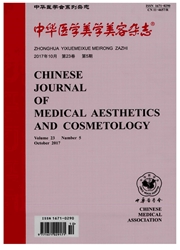

 中文摘要:
中文摘要:
目的探讨体外培养成人脂肪干细胞的相关老化机制。方法成人脂肪干细胞来源于临床脂肪抽吸者,在干细胞培养液和恒温恒湿培养箱中连续传代培养建立老化模型。定期观察细胞形态变化,并分别进行细胞衰老相关的伊半乳糖苷酶染色、γH2AX染色和实时定量聚合酶链式反应(PCR)检测。结果脂肪干细胞体外连续培养数目倍增(PD)大于35时细胞周期停滞,进入老化期。细胞衰老相关的β-半乳糖苷酶染色和γH2AX染色呈阳性;实时定量PCR结果显示,Nanog基因和Oct4基因的表达在自我更新干细胞(PD〈20)和老化脂肪干细胞(PD〉35)差异有统计学意义(P〈0.05)。结论成人脂肪干细胞体外传代培养,可产生类似其在体内的老化过程,建立脂肪干细胞的老化模型,为抗衰老药物提供新的模型,为抗衰老治疗提供新的靶点,对组织工程及再生医学研究有着重要意义。
 英文摘要:
英文摘要:
Objective To explore the aging mechanisms of human adult adipose-derived stem cells (bADSCs) in vitro. Methods The hADSCs came from the production of normal patients with li- posuction. The hADSCs were cultured in the 37℃ incubator and passed until the cells were senescent. The senescence-associated β-gal staining (SA-β-gal) and histone protein γH2 AX staining were carried out in both young and old hADSCs. The quantitative real-time PCR (qRT-PCR) was conducted to check the difference of the transcription function of the young and old hADSCs. Results The cultured hADSCs would be the senescent cells when the PD number was more than 35. The aging cells became big and had large flat nuclei and much more lososomes in the cytoplasm. The SA-β-gal staining and γH2 AX staining were mostly positive in the aging hADSCs (PD〉 35) compared with the self-renewing hADSCs (PD〉20). The qRT-PCR results showed that the transcription levels of Nanog and Oct4 gene were very low in aging hADSCs compared with the self-renewing ones. Conclusions The hADSCs will be senescent (SEN) when cultured and passed in vitro for long time and the aging process is similar to that of stem cells in vivo. The aging model of hADSCs can be established by this method and will be very useful in the anti-aging drug, regeneration medicine, tissue engineering and stem cell therapy.
 同期刊论文项目
同期刊论文项目
 同项目期刊论文
同项目期刊论文
 期刊信息
期刊信息
